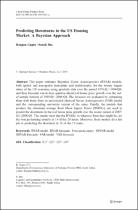JavaScript is disabled for your browser. Some features of this site may not work without it.
- ResearchSpace
- →
- Research Publications/Outputs
- →
- Journal Articles
- →
- View Item
| dc.contributor.author |
Gupta, R

|
|
| dc.contributor.author |
Das, Sonali

|
|
| dc.date.accessioned | 2010-10-12T09:00:17Z | |
| dc.date.available | 2010-10-12T09:00:17Z | |
| dc.date.issued | 2010-10 | |
| dc.identifier.citation | Gupta, R and Das, S. 2010. Predicting downturns in the US housing market: a Bayesian approach. Journal of Real Estate Finance and Economics, Vol. 41(3), pp 294-319 | en |
| dc.identifier.issn | 0895-5638 | |
| dc.identifier.uri | http://www.springerlink.com/index/w752464096652861.pdf | |
| dc.identifier.uri | http://hdl.handle.net/10204/4481 | |
| dc.description | Copyright: 2010 Springer. This is the post print version of the work. The definitive version is published in the Journal of Real Estate Finance and Economics, Vol. 41(3), pp 294-319 | en |
| dc.description.abstract | This paper estimates Bayesian Vector Autoregressive (BVAR) models, both spatial and non-spatial (univariate and multivariate), for the twenty largest states of the US economy, using quarterly data over the period 1976:Q1–1994:Q4; and then forecasts one-to-four quarters-ahead real house price growth over the out-of- sample horizon of 1995:Q1–2006:Q4. The forecasts are evaluated by comparing them with those from an unrestricted classical Vector Autoregressive (VAR) model and the corresponding univariate variant of the same. Finally, the models that produce the minimum average Root Mean Square Errors (RMSEs), are used to predict the downturns in the real house price growth over the recent period of 2007: Q1–2008:Q1. The results show that the BVARs, in whatever form they might be, are the best performing models in 19 of the 20 states. Moreover, these models do a fair job in predicting the downturn in 18 of the 19 states | en |
| dc.language.iso | en | en |
| dc.publisher | Springer | en |
| dc.relation.ispartofseries | Journal Article | en |
| dc.subject | Bayesian vector autoregressive | en |
| dc.subject | BVAR | en |
| dc.subject | BVAR forecasts | en |
| dc.subject | Forecast accuracy | en |
| dc.subject | US housing market | en |
| dc.title | Predicting downturns in the US housing market: a Bayesian approach | en |
| dc.type | Article | en |
| dc.identifier.apacitation | Gupta, R., & Das, S. (2010). Predicting downturns in the US housing market: a Bayesian approach. http://hdl.handle.net/10204/4481 | en_ZA |
| dc.identifier.chicagocitation | Gupta, R, and Sonali Das "Predicting downturns in the US housing market: a Bayesian approach." (2010) http://hdl.handle.net/10204/4481 | en_ZA |
| dc.identifier.vancouvercitation | Gupta R, Das S. Predicting downturns in the US housing market: a Bayesian approach. 2010; http://hdl.handle.net/10204/4481. | en_ZA |
| dc.identifier.ris | TY - Article AU - Gupta, R AU - Das, Sonali AB - This paper estimates Bayesian Vector Autoregressive (BVAR) models, both spatial and non-spatial (univariate and multivariate), for the twenty largest states of the US economy, using quarterly data over the period 1976:Q1–1994:Q4; and then forecasts one-to-four quarters-ahead real house price growth over the out-of- sample horizon of 1995:Q1–2006:Q4. The forecasts are evaluated by comparing them with those from an unrestricted classical Vector Autoregressive (VAR) model and the corresponding univariate variant of the same. Finally, the models that produce the minimum average Root Mean Square Errors (RMSEs), are used to predict the downturns in the real house price growth over the recent period of 2007: Q1–2008:Q1. The results show that the BVARs, in whatever form they might be, are the best performing models in 19 of the 20 states. Moreover, these models do a fair job in predicting the downturn in 18 of the 19 states DA - 2010-10 DB - ResearchSpace DP - CSIR KW - Bayesian vector autoregressive KW - BVAR KW - BVAR forecasts KW - Forecast accuracy KW - US housing market LK - https://researchspace.csir.co.za PY - 2010 SM - 0895-5638 T1 - Predicting downturns in the US housing market: a Bayesian approach TI - Predicting downturns in the US housing market: a Bayesian approach UR - http://hdl.handle.net/10204/4481 ER - | en_ZA |






